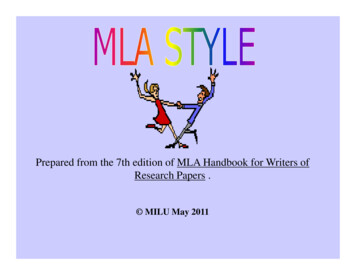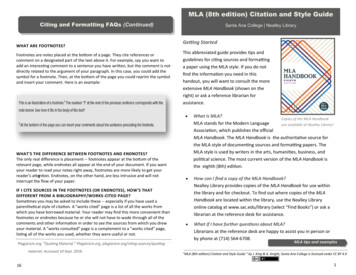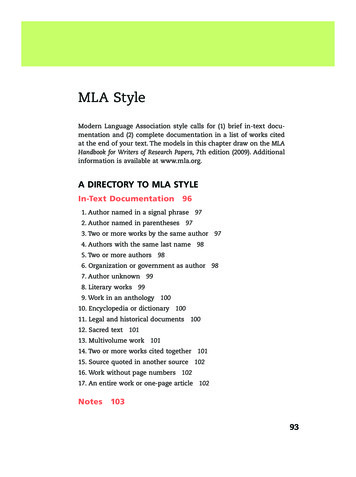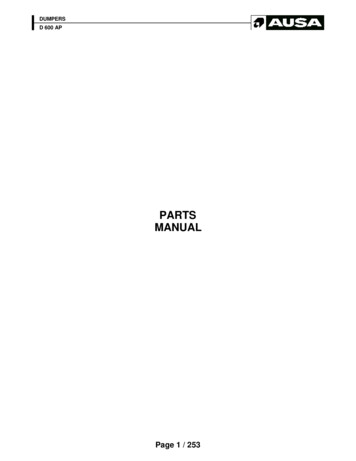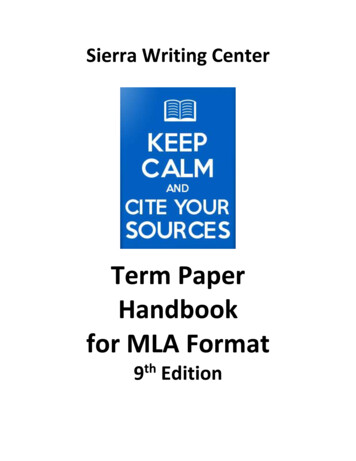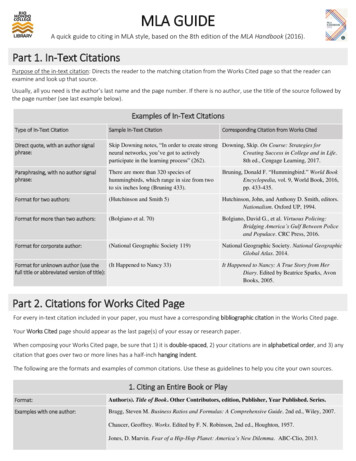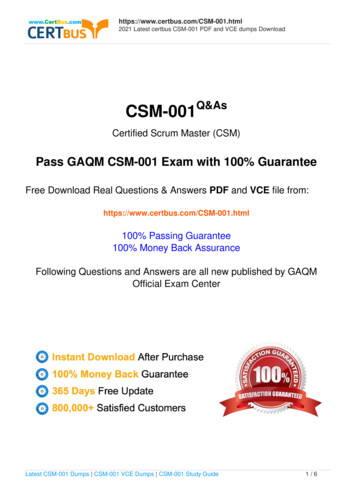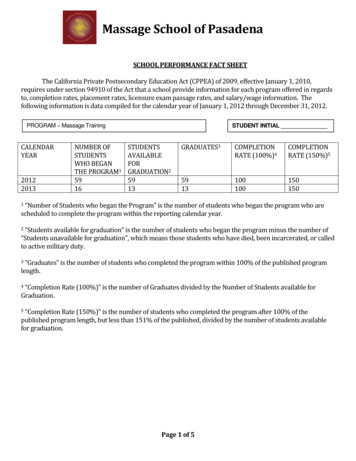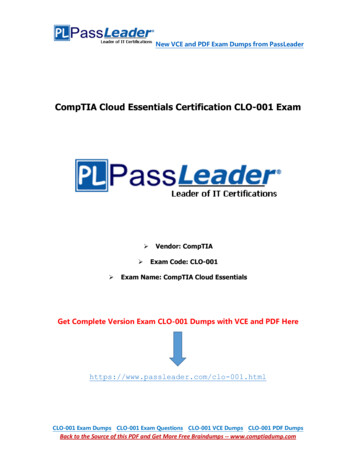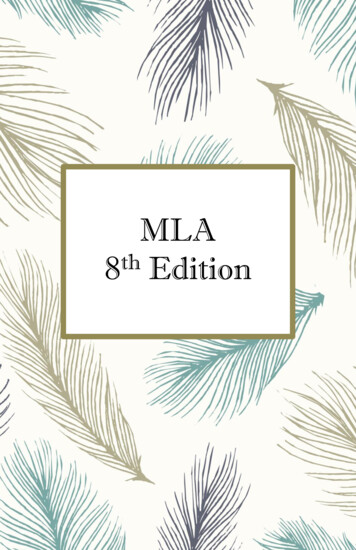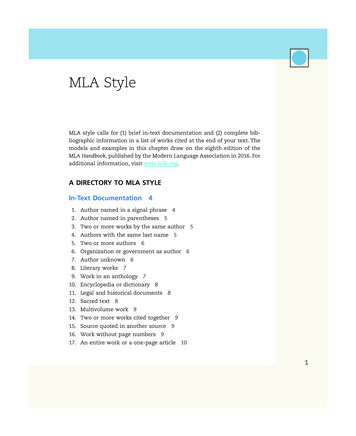
Transcription
MLA StyleMLA style calls for (1) brief in-text documentation and (2) complete bibliographic information in a list of works cited at the end of your text. Themodels and examples in this chapter draw on the eighth edition of theMLA Handbook, published by the Modern Language Association in 2016. Foradditional information, visit style.mla.org.A DIRECTORY TO MLA STYLEIn-Text Documentation41. Author named in a signal phrase 42. Author named in parentheses 53. Two or more works by the same author 54. Authors with the same last name 55. Two or more authors 66. Organization or government as author 67. Author unknown 68. Literary works 79. Work in an anthology 710. Encyclopedia or dictionary 811. Legal and historical documents 812. Sacred text 813. Multivolume work 914. Two or more works cited together 915. Source quoted in another source 916. Work without page numbers 917. An entire work or a one-page article 101BUL 61707 MLA 001-049.indd 124/06/16 5:56 PM
2MLA StyleNotes10List of Works Cited1111CORE ELEMENTS14AUTHORS AND OTHER CONTRIBUTORS1. One author142. Two authors143. Three or more authors 144. Two or more works by the same author 155. Author and editor or translator 156. No author or editor 157. Organization or government as author 1616ARTICLES AND OTHER SHORT WORKS8. Article in a journal 169. Article in a magazine 1810. Article in a newspaper2011. Article accessed through a database12. Entry in a reference work202213. Editorial 2214. Letter to the editor15. Review232316. Comment on an online articleBOOKS AND PARTS OF BOOKS2417. Basic entries for a book18. Anthology252519. Work in an anthology20. Multivolume work21. Book in a series22. Graphic narrativeBUL 61707 MLA 001-049.indd 2242527272824/06/16 5:56 PM
MLA Style23. Sacred text32824. Edition other than the first25. Republished work282826. Foreword, introduction, preface, or afterword27. Published letter292928. Paper at a conference2929. Dissertation 30WEBSITES3030. Entire website3031. Work on a website32. Blog entry33. Wiki323232PERSONAL COMMUNICATION AND SOCIAL MEDIA34.35.36.37.38.32Personal letter 32Email 32Text message 33Post to an online forum 33Post to Twitter, Facebook, or other social media 33AUDIO, VISUAL, AND OTHER SOURCES39. Advertisement40. Art34343441. Cartoon3542. Supreme Court case43. Film44. Interview45. Map363646. Musical score47. Online video363648. Oral presentation49. PodcastBUL 61707 MLA 001-049.indd 33535373724/06/16 5:56 PM
4MLA Style50. Radio program3751. Sound recording52. TV show373853. Video game38Formatting a Research PaperSample Research Paper3940Throughout this chapter, you’ll find models and examples that are colorcoded to help you see how writers include source information in their textsand in their lists of works cited: tan for author, editor, translator, and othercontributors; yellow for titles; gray for publication information — date ofpublication, page number(s) or other location information, and so on.IN-TEXT DOCUMENTATIONBrief documentation in your text makes clear to your reader what youtook from a source and where in the source you found the information.In your text, you have three options for citing a source: quoting, paraphrasing, and summarizing. As you cite each source, you will need todecide whether or not to name the author in a signal phrase — “as ToniMorrison writes” — or in parentheses — “(Morrison 24).”The first examples below show basic in-text documentation of a workby one author. Variations on those examples follow. The examples illustrate the MLA style of using quotation marks around titles of short worksand italicizing titles of long works.1. AUTHOR NAMED IN A SIGNAL PHRASEIf you mention the author in a signal phrase, put only the page number(s)in parentheses. Do not write page or p.McCullough describes John Adams’s hands as those of someone used tomanual labor (18).authorBUL 61707 MLA 001-049.indd 4titlepublication24/06/16 5:56 PM
MLA Style52. AUTHOR NAMED IN PARENTHESESIf you do not mention the author in a signal phrase, put his or her lastname in parentheses along with the page number(s). Do not use punctuation between the name and the page number(s).Adams is said to have had “the hands of a man accustomed to pruninghis own trees, cutting his own hay, and splitting his own firewood”(McCullough 18).Whether you use a signal phrase and parentheses or parentheses only, tryto put the parenthetical documentation at the end of the sentence or asclose as possible to the material you’ve cited — without awkwardly interrupting the sentence. Notice that in the example above, the parentheticalreference comes after the closing quotation marks but before the periodat the end of the sentence.3. TWO OR MORE WORKS BY THE SAME AUTHORIf you cite multiple works by one author, include the title of the work youare citing either in the signal phrase or in parentheses. Give the full titleif it’s brief; otherwise, give a short version.Kaplan insists that understanding power in the Near East requires“Western leaders who know when to intervene, and do so withoutd 330).illusions” (EastwardPut a comma between author and title if both are in the parentheses.Understanding power in the Near East requires “Western leaders whoknow when to intervene, and do so without illusions” (Kaplan,Eastwardd 330).4. AUTHORS WITH THE SAME LAST NAMEGive the author’s first and last names in any signal phrase, or add theauthor’s first initial in the parenthetical reference.BUL 61707 MLA 001-049.indd 524/06/16 5:56 PM
6MLA StyleImaginative applies not only to modern literature but also to writing ofall periods, whereas magical is often used in writing about Arthurianromances (A. Wilson 25).5. TWO OR MORE AUTHORSFor a work with two authors, name both, either in a signal phrase or inparentheses.Carlson and Ventura’s stated goal is to introduce Julio Cortázar,Marjorie Agosín, and other Latin American writers to an audience ofEnglish-speaking adolescents (v).For a work by three or more authors, name the first author followed by et al.One popular survey of American literature breaks the contents intosixteen thematic groupings (Anderson et al. A19-24).6. ORGANIZATION OR GOVERNMENT AS AUTHORAcknowledge the organization either in a signal phrase or in parentheses.It’s acceptable to shorten long names.The US government can be direct when it wants to be. For example, itsternly warns, “If you are overpaid, we will recover any payments notdue you” (Social Security Administration 12).7. AUTHOR UNKNOWNIf you don’t know the author, use the work’s title or a shortened versionof the title in the parenthetical reference.A powerful editorial in last week’s paper asserts that healthy liver donorMike Hurewitz died because of “frightening” faulty postoperative care(“Every Patient’s Nightmare”).authorBUL 61707 MLA 001-049.indd 6titlepublication24/06/16 5:56 PM
MLA Style78. LITERARY WORKSWhen referring to literary works that are available in many different editions, give the page numbers from the edition you are using, followed byinformation that will let readers of any edition locate the text you are citing.NOVELS. Give the page and chapter number, separated by a semicolon.In Pride and Prejudice, Mrs. Bennet shows no warmth toward Jane andElizabeth when they return from Netherfield (105; ch. 12).VERSE PLAYS. Give act, scene, and line numbers, separated with periods.Macbeth continues the vision theme when he says, “Thou hast nospeculation in those eyes / Which thou dost glare with” (3.3.96-97).POEMS. Give the part and the line numbers (separated by periods). If a poemhas only line numbers, use the word line(s) only in the first reference.Whitman sets up not only opposing adjectives but also opposing nounsin “Song of Myself” when he says, “I am of old and young, of the foolishas much as the wise, / . . . a child as well as a man” (16.330-32).One description of the mere in Beowulff is “not a pleasant place” (line1372). Later, it is labeled “the awful place” (1378).9. WORK IN AN ANTHOLOGYName the author(s) of the work, not the editor of the anthology — eitherin a signal phrase or in parentheses.“It is the teapots that truly shock,” according to Cynthia Ozick in heressay on teapots as metaphor (70).In In Short: A Collection of Creative Nonfiction, readers will find both anessay on Scottish tea (Hiestand) and a piece on teapots as metaphors (Ozick).BUL 61707 MLA 001-049.indd 724/06/16 5:56 PM
8MLA Style10. ENCYCLOPEDIA OR DICTIONARYAcknowledge an entry in an encyclopedia or dictionary by giving theauthor’s name, if available. For an entry without an author, give the entry’stitle in parentheses. If entries are arranged alphabetically, no page numberis needed.According to Funk & Wagnall’s New World Encyclopedia, early in hiscareer Kubrick’s main source of income came from “hustling chessgames in Washington Square Park” (“Kubrick, Stanley”).11. LEGAL AND HISTORICAL DOCUMENTSFor legal cases and acts of law, name the case or act in a signal phrase orin parentheses. Italicize the name of a legal case.In 2005, the Supreme Court confirmed in MGM Studios, Inc. v. Grokster,Ltd. that peer-to-peer file sharing is copyright infringement.Do not italicize the titles of laws, acts, or well-known historical documentssuch as the Declaration of Independence. Give the title and any relevantarticles and sections in parentheses. It’s fine to use common abbreviationssuch as art. or sec. and to abbreviate well-known titles.The president is also granted the right to make recess appointments(US Const., art. 2, sec. 2).12. SACRED TEXTWhen citing a sacred text such as the Bible or the Qur’an for the first time,give the title of the edition, and in parentheses give the book, chapter, andverse (or their equivalent), separated by periods. MLA recommends abbreviating the names of the books of the Bible in parenthetical references. Latercitations from the same edition do not have to repeat its title.The wording from The New English Bible follows: “In the beginning ofcreation, when God made heaven and earth, the earth was without formand void, with darkness over the face of the abyss, and a mighty windthat swept over the surface of the waters” (Gen. 1.1-2).authorBUL 61707 MLA 001-049.indd 8titlepublication24/06/16 5:56 PM
MLA Style913. MULTIVOLUME WORKIf you cite more than one volume of a multivolume work, each time youcite one of the volumes, give the volume and the page number(s) in parentheses, separated by a colon and a space.Sandburg concludes with the following sentence about those paying lastrespects to Lincoln: “All day long and through the night the unbrokenline moved, the home town having its farewell” (4: 413).If your works cited list includes only a single volume of a multivolumework, give just the page number in parentheses.14. TWO OR MORE WORKS CITED TOGETHERIf you’re citing two or more works closely together, you will sometimesneed to provide a parenthetical reference for each one.Tanner (7) and Smith (viii) have looked at works from a cultural perspective.If you include both in the same parentheses, separate the references witha semicolon.Critics have looked at both Pride and Prejudice and Frankenstein froma cultural perspective (Tanner 7; Smith viii).15. SOURCE QUOTED IN ANOTHER SOURCEWhen you are quoting text that you found quoted in another source, usethe abbreviation qtd. in in the parenthetical reference.Charlotte Brontë wrote to G. H. Lewes: “Why do you like Miss Austen sovery much? I am puzzled on that point” (qtd. in Tanner 7).16. WORK WITHOUT PAGE NUMBERSFor works without page numbers, including many online sources, identifythe source using the author or other information either in a signal phraseor in parentheses.BUL 61707 MLA 001-049.indd 924/06/16 5:56 PM
10MLA StyleStudies show that music training helps children to be better at multitasking later in life (”Hearing the Music”).If the source has chapter, paragraph, or section numbers, use them withthe abbreviations ch., par., or sec.: (“Hearing the Music,” par. 2). Alternatively,you can refer to a heading on a screen to help readers locate text.Under the heading “The Impact of the Railroad,” Rawls notes that thetranscontinental railroad was called an iron horse and a greedy octopus.For an audio or a video recording, give the hours, minutes, and seconds(separated by colons) as shown on the player: (00:05-08:30).17. AN ENTIRE WORK OR A ONE-PAGE ARTICLEIf you cite an entire work rather than a part of it, or if you cite a singlepage article, there’s no need to include page numbers.Throughout life, John Adams strove to succeed (McCullough).NOTESSometimes you may need to give information that doesn’t fit into the textitself — to thank people who helped you, to provide additional details, torefer readers to other sources, or to add comments about sources. Suchinformation can be given in a footnote (at the bottom of the page) or anendnote (on a separate page with the heading Notes just before your workscited list). Put a superscript number at the appropriate point in your text,signaling to readers to look for the note with the corresponding number.If you have multiple notes, number them consecutively throughout yourpaper.TEXTThis essay will argue that small liberal arts colleges should not recruitathletes and, more specifically, that giving student athletes preferentialtreatment undermines the larger educational goals.1authorBUL 61707 MLA 001-049.indd 10titlepublication24/06/16 5:56 PM
MLA Style11NOTE1. I want to thank all those who have contributed to my thinkingon this topic, especially my classmates and my teacher Marian Johnson.LIST OF WORKS CITEDA works cited list provides full bibliographic information for every sourcecited in your text. See page 40 for guidelines on formatting this list andpage 48 for a sample works cited list.Core ElementsThe new MLA style provides a list of “core elements” for documentingsources, advising writers to list as many of them as possible in the orderthat MLA specifies. We’ve used these general principles to provide templates and examples for documenting 53 kinds of sources college writersmost often need to cite, and the following general guidelines for how totreat each of the core elements.AUTHORS AND OTHER CONTRIBUTORS If there is one author, list the name last name first: Morrison, Toni. If there are two authors, list the first author last name first and thesecond one first name first: Lunsford, Andrea, and Lisa Ede. Put theirnames in the order given in the work. If there are three or more authors, give the first author’s name followedby et al.: Rose, Mike, et al. Include any middle names or initials: Heath, Shirley Brice; Toklas, Alice B. If you’re citing an editor, translator, or others who are not authors,specify their role. For works with multiple contributors, put the onewhose work you wish to highlight before the title, and list any othersyou want to mention after the title. For contributors named beforethe title, put the label after the name: Fincher, David, director. ForBUL 61707 MLA 001-049.indd 1125/06/16 5:20 PM
12MLA Stylethose named after the title, specify their role first: directed by DavidFincher.TITLES Include any subtitles and capitalize all the words in titles and subtitlesexcept for articles (a, an, the), prepositions (to, at, from, and so on), andcoordinating conjunctions (and, but, for, or, nor, yet) — unless they arethe first or last word of a title or subtitle. Italicize the titles of books, periodicals, and other long whole works(Pride and Prejudice, Wired), even if they are part of a larger work. Enclose in quotation marks the titles of short works and sources thatare part of larger works: “Letter from Birmingham Jail.” To document a source that has no title, describe it without italics orquotation marks: Letter to the author, Review of doo wop concert.PUBLICATION INFORMATION Write publishers’ names in full, but omit words like Company or Inc. For university presses, use U for “University” and P for “Press”:Princeton UP, U of California P.DATES Whether to give just the year or to include the month and day dependson the source. Give the full date that you find there. For books, give the year of publication: 1948. If a book lists more thanone date, use the most recent one. Periodicals may be published annually, monthly, seasonally, weekly,or daily. Give the full date that you find in the periodical: 2011, Apr.2011, Spring 2011, 16 Apr. 2011. Abbreviate the months except for May, June, and July: Jan., Feb., Mar.,Apr., Aug., Sept., Oct., Nov., Dec. Because online sources often change or even disappear, provide thedate on which you accessed them: Accessed 6 June 2015.authorBUL 61707 MLA 001-049.indd 12titlepublication24/06/16 5:56 PM
MLA Style 13If an online source includes the time when it was posted or modified,include the time along with the date: 18 Oct. 2005, 9:20 a.m.LOCATION For most print articles and other short works, help readers locate thesource by giving a page number or range of pages: p. 24, pp. 24-35. Forthose that are not on consecutive pages, give the first page numberwith a plus sign: pp. 24 . For online sources, give the URL, omitting http:// or https://. If a sourcehas a permalink, give that. For sources found in a database, give the DOI for any that have one.Otherwise, give the URL. For physical objects that you find in a museum, archive, or some otherplace, give the name of the place and its city: Menil Collection, Houston.Omit the city if it’s part of the place’s name: Boston Public Library. For performances or other live presentations, name the venue and itscity: Mark Taper Forum, Los Angeles. Omit the city if it’s part of theplace’s name: Berkeley Repertory Theatre.PUNCTUATION Use a period after the author name(s) that start an entry (Morrison,Toni.) and the title of the source you’re documenting (Beloved.) Use a comma between the author’s last and first names: Morrison, Toni. Sometimes you’ll need to provide information about more than onework for a single source — for instance, when you cite an article froma periodical that you access through a database. MLA refers to theperiodical and database (or any other entity that holds a source) as“containers.” Use commas between elements within each containerand put a period at the end of each container. For example:Semuels, Alana. “The Future Will Be Quiet.” The Atlantic, Apr. 2016,pp. 19-20. ProQuest, search.proquest.com/docview/1777443553?accountid 42654. Accessed 5 Apr. 2016.BUL 61707 MLA 001-049.indd 1324/06/16 5:56 PM
14MLA StyleThe guidelines below should help you document kinds of sourcesyou’re likely to use. The first section shows how to acknowledge authorsand other contributors and applies to all kinds of sources — print, online,or others. Later sections show how to treat titles, publication information,location, and access information for many specific kinds of sources. Ingeneral, provide as much information as possible for each source — enoughto tell readers how to find a source if they wish to access it themselves.Authors and Other ContributorsWhen you name authors and other contributors in your citations, you arecrediting them for their work and letting readers know who’s in on the conversation. The following guidelines for citing authors and other contributors apply to all sources you cite: in print, online, or in some other media.1. ONE AUTHORAuthor’s Last Name, First Name. Title. Publisher, Date.Anderson, Curtis. The Long Tail: Why the Future of Business Is SellingLess of More. Hyperion, 2006.2. TWO AUTHORS1st Author’s Last Name, First Name, and 2nd Author’s First and LastNames. Title. Publisher, Date.Lunsford, Andrea, and Lisa Ede. Singular Texts/Plural Authors:Perspectives on Collaborative Writing. Southern Illinois UP, 1990.3. THREE OR MORE AUTHORS1st Author’s Last Name, First Name, et al. Title. Publisher, Date.Sebranek, Patrick, et al. Writers INC: A Guide to Writing, Thinking, andLearning. Write Source, 1990.authorBUL 61707 MLA 001-049.indd 14titlepublication24/06/16 5:56 PM
MLA Style154. TWO OR MORE WORKS BY THE SAME AUTHORGive the author’s name in the first entry, and then use three hyphens inthe author slot for each of the subsequent works, listing them alphabetically by the first important word of each title.Author’s Last Name, First Name. Title That Comes First Alphabetically.Publisher, Date.- - -. Title That Comes Next Alphabetically. Publisher, Date.Kaplan, Robert D. The Coming Anarchy: Shattering the Dreams of thePost Cold War. Random House, 2000.- - -. Eastward to Tartary: Travels in the Balkans, the Middle East, and theCaucasus. Random House, 2000.5. AUTHOR AND EDITOR OR TRANSLATORAuthor’s Last Name, First Name. Title. Role by First and Last Names,Publisher, Date.Austen, Jane. Emma. Edited by Stephen M. Parrish, W. W. Norton, 2000.Dostoevsky, Fyodor. Crime and Punishment. Translated by Richard Pevearand Larissa Volokhonsky, Vintage Books, 1993.Start with the editor or translator if you are focusing on that contributionrather than the author’s.Pevear, Richard, and Larissa Volokhonsky, translators. Crime andPunishment. By Fyodor Dostoevsky, Vintage Books, 1993.6. NO AUTHOR OR EDITORWhen there’s no known author or editor, start with the title.The Turner Collection in the Clore Gallery. Tate Publications, 1987.“Being Invisible Closer to Reality.“ The Atlanta Journal-Constitution,11 Aug. 2008, p. A3.BUL 61707 MLA 001-049.indd 1524/06/16 5:56 PM
16MLA Style7. ORGANIZATION OR GOVERNMENT AS AUTHOROrganization Name. Title. Publisher, Date.Diagram Group. The Macmillan Visual Desk Reference. Macmillan, 1993.For a government publication, give the name of the government first, followed by the names of any department and agency.United States, Department of Health and Human Services, NationalInstitute of Mental Health. Autism Spectrum Disorders.Government Printing Office, 2004.When the organization is both author and publisher, start with the titleand list the organization only as the publisher.Stylebook on Religion 2000: A Reference Guide and Usage Manual.Catholic News Service, 2002.Articles and Other Short WorksArticles, essays, reviews, and other shorts works are found in journals,magazines, newspapers, other periodicals, and books — all of which youmay find in print, online, or in a database. For most short works, you’ll needto provide information about the author, the titles of both the short workand the longer work, any page numbers, and various kinds of publicationinformation, all explained below.8. ARTICLE IN A JOURNALPRINTAuthor’s Last Name, First Name. “Title of Article.” Name of Journal,Volume, Issue, Date, Pages.authorBUL 61707 MLA 001-049.indd 16titlepublication24/06/16 5:56 PM
MLA Style17Documentation Map (MLA)Article in a Print JournalTitle of articleAuthorVolumeIssueYearName of journalNeuhaus, Jessamyn. “Marge Simpson, Blue-Haired Housewife: DefiningDomesticity on The Simpsons.” The Journal of Popular Culture,vol. 43, no. 4, 2010, pp. 761-81.BUL 61707 MLA 001-049.indd 1724/06/16 5:56 PM
18MLA StyleCooney, Brian C. “Considering Robinson Crusoe’s ‘Liberty of Conscience’in an Age of Terror.” College English, vol. 69, no. 3, Jan. 2007,pp. 197-215.ONLINEAuthor’s Last Name, First Name. “Title of Article.” Name of Journal,Volume, Issue, Date, Pages (if any), URL. Accessed Day Month Year.Gleckman, Jason. “Shakespeare as Poet or Playwright? The Player’s Speechin Hamlet.” Early Modern Literary Studies, vol. 11, no. 3, Jan. 2006,purl.oclc.org/emls/11-3/glechaml.htm. Accessed 31 Mar. 2015.9. ARTICLE IN A MAGAZINEPRINTAuthor’s Last Name, First Name. “Title of Article.” Name of Magazine,Date, Pages.Neyfakh, Leon. “The Future of Getting Arrested.” The Atlantic, Jan.-Feb.2015, pp. 26 .ONLINEAuthor’s Last Name, First Name. “Title of Article.” Name of Magazine,Date on web, Pages (if any), URL. Accessed Day Month Year.Khazan, Olga. “Forgetting and Remembering Your First Language.”The Atlantic, 24 July 2014, uage/374906/. Accessed 2 Apr. 2015.authorBUL 61707 MLA 001-049.indd 18titlepublication24/06/16 5:56 PM
19MLA StyleDocumentation Map (MLA)Article in an Online MagazineURLName ofmagazineTitle ofarticleAuthorDateSegal, Michael. “The Hit Book That Came from Mars.” Nautilus,8 Jan. 2015, e-from-mars. Accessed 10 Oct. 2016.BUL 61707 MLA 001-049.indd 1924/06/16 5:56 PM
20MLA Style10. ARTICLE IN A NEWSPAPERPRINTAuthor’s Last Name, First Name. “Title of Article.” Name of Newspaper,Date, Pages.Saulny, Susan, and Jacques Steinberg. “On College Forms, a Question ofRace Can Perplex.” The New York Times, 14 June 2011, p. A1.To document a particular edition of a newspaper, list the edition (late ed.,natl. ed., and so on) after the date. If a section of the newspaper is numbered, put that detail after the edition information.Burns, John F., and Miguel Helft. “Under Pressure, YouTube WithdrawsMuslim Cleric’s Videos.” The New York Times, 4 Nov. 2010, late ed.,sec. 1, p. 13.ONLINEAuthor’s Last Name, First Name. “Title of Article.” Name of Newspaper,Date on web, URL. Accessed Day Month Year.Banerjee, Neela. “Proposed Religion-Based Program for Federal InmatesIs Canceled.” The New York Times, 28 Oct. 2006, www.nytimes.com/2006/10/28/us/28prison.html? r 0. Accessed 4 Apr. 2015.11. ARTICLE ACCESSED THROUGH A DATABASEAuthor’s Last Name, First Name. “Title of Article.” Name of Periodical,Volume, Issue, Date, Pages. Name of Database, DOI or URL.Accessed Day Month Year.Stalter, Sunny. “Subway Ride and Subway System in Hart Crane’s ‘TheTunnel.’” Journal of Modern Literature, vol. 33, no. 2, Jan. 2010,pp. 70-91. JSTOR, doi: 10.2979/jml.2010.33.2.70. Accessed 30 Mar.2015.authorBUL 61707 MLA 001-049.indd 20titlepublication24/06/16 5:56 PM
MLA Style21Documentation Map (MLA)Journal Article Accessed through a DatabaseURLName ofdatabaseTitle of articleAuthorPagesName ofperiodicalVolume,issue, dateNeuhaus, Jessamyn. “Marge Simpson, Blue-Haired Housewife: DefiningDomesticity on The Simpsons.” Journal of Popular Culture, vol. 43,no. 4, Aug. 2010, pp. 761-81. SPORT Discus with Full Text, ezproxy.libraries.wright.edu/login?url http://search.ebscohost.com/login.aspx?direct true&db a9h&AN 52300944&site ehost-live. Accessed 24 Mar.2016.BUL 61707 MLA 001-049.indd 2124/06/16 5:56 PM
22MLA Style12. ENTRY IN A REFERENCE WORKPRINTAuthor’s Last Name, First Name (if any). “Title of Entry.” Title ofReference Book, edited by Editor’s First and Last Names (if any),Edition number, Publisher, Date, Pages.“California.” The New Columbia Encyclopedia, edited by William H.Harris and Judith S. Levey, 4th ed., Columbia UP, 1975, pp. 423-24.If there’s no author given, start with the title of the entry.“Feminism.” Longman Dictionary of American English, Longman, 1983,p. 252.ONLINEDocument online reference works the same as print ones, adding the URLand access date after the date of publication.“Baseball.” The Columbia Electronic Encyclopedia, edited by Paul Lagassé,6th ed., Columbia UP, 2012. www.infoplease.com/encyclopedia.Accessed 25 May 2016.13. EDITORIALPRINT“Title of Editorial.” Editorial. Name of Periodical, Date, Page.“Gas, Cigarettes Are Safe to Tax.” Editorial. The Lakeville Journal, 17 Feb.2005, p. A10.authorBUL 61707 MLA 001-049.indd 22titlepublication24/06/16 5:56 PM
MLA Style23ONLINE“Title of Editorial.” Editorial. Name of Periodical, Date on web, URL.Accessed Day Month Year.“Keep the Drinking Age at 21.” Editorial. Chicago Tribune, 28 Aug.2008, 0487 es. Accessed26 Apr. 2015.14. LETTER TO THE EDITORAuthor’s Last Name, First Name. “Title of Letter (if any).” Letter. Nameof Periodical, Date on web, URL. Accessed Day Month Year.Pinker, Steven. “Language Arts.” Letter. The New Yorker, 4 June e-arts-2. Accessed6 Apr. 2015.15. REVIEWPRINTReviewer’s Last Name, First Name. “Title of Review.” Review of Title, byAuthor’s First and Last Names. Name of Periodical, Date, Pages.Frank, Jeffrey. “Body Count.” Review of The Exception, by ChristianJungersen. The New Yorker, 30 July 2007, pp. 86-87.If a review has no author or title, start with what’s being reviewed:Review of Ways to Disappear, by Idra Novey. The New Yorker, 28 Mar.2016, p. 79.BUL 61707 MLA 001-049.indd 2324/06/16 5:56 PM
24MLA StyleONLINEReviewer’s Last Name, First Name. “Title of Review.” Review of Title,by Author’s First and Last Names. Name of Periodical, Date, URL.Accessed Day Month Year.Donadio, Rachel. “Italy’s Great, Mysterious Storyteller.” Reviewof My Brilliant Friend, by Elena Ferrante. The New York Reviewof Books, 18 Dec. 2014, ysterious-storyteller. Accessed 28 Sept. 2015.16. COMMENT ON AN ONLINE ARTICLECommenter. Comment on “Title of Article.” Name of Periodical,Date posted, Time posted, URL. Accessed Day Month Year.Nick. Comment on “The Case for Reparations.” The Atlantic, 22 May2014, 3:04 p.m., Accessed 8 May 2015.Books and Parts of BooksFor most books, you’ll need to provide information about the author, thetitle, the publisher, and the year of publication. If you found the bookinside a larger volume, a database, or some other work, be sure to specifythat as well.authorBUL 61707 MLA 001-049.indd 24titlepublication24/06/16 5:56 PM
MLA Style2517. BASIC ENTRIES FOR A BOOKPRINTAuthor’s Last Name, First Name. Title. Publisher, Year of publication.Watson, Brad. Miss Jane. W. W. Norton, 2016.EBOOKDocument an ebook as you would a print book, but add information aboutthe ebook — or the type of ebook if you know it.Watson, Brad. Miss Jane. Ebook, W. W. Norton, 2016.Watson, Brad. Miss Jane. Kindle ed., W. W. Norton, 2016.IN A DATABASEAuthor’s Last
MLA Handbook, published by the Modern Language Association in 2016. For additional information, visit style.mla.org. A DIRECTORY TO MLA STYLE In-Text Documentation 4 1. Author named in a signal phrase 4 2. Author named in parentheses 5 3. Two or more works by the same author 5 4. Authors with the same last name 5 5. Two or more authors 6 6.
